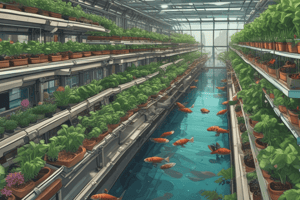Podcast
Questions and Answers
What is the primary purpose of community gardening in urban farming?
What is the primary purpose of community gardening in urban farming?
- To provide space for citizens to cultivate plants (correct)
- To enhance agricultural machinery use
- To solely generate profit for local businesses
- To promote only private ownership of land
How does urban farming contribute to healthier diets?
How does urban farming contribute to healthier diets?
- By reducing the intake of fruits and vegetables
- By promoting high-calorie fast food consumption
- By offering processed food options
- By increasing access to low-cost, nutrient-rich food sources (correct)
What are 'food miles' in the context of urban farming?
What are 'food miles' in the context of urban farming?
- The speed at which food is processed
- The distance food travels from farm to consumer (correct)
- The number of animals raised on a farm
- The total number of plants grown in a garden
What is one of the benefits of minimizing food miles through urban farming?
What is one of the benefits of minimizing food miles through urban farming?
What type of urban farming includes land privately owned by businesses?
What type of urban farming includes land privately owned by businesses?
How does urban farming support local employment?
How does urban farming support local employment?
What essential part of life does urban farming connect within a community?
What essential part of life does urban farming connect within a community?
Flashcards are hidden until you start studying
Study Notes
Types of Urban Farming
- Gardens: Community gardens are public spaces where citizens grow plants for food, recreation, and education, enhancing understanding of horticulture and food production.
- Farms: Agricultural lands in urban areas focus on both animal and plant food production, mainly through community-run gardens fostering relationships and agricultural awareness.
- Sub-categories include:
- Private Gardens: These are typically owned by individuals or private businesses, including rooftops and vertical gardens.
Benefits of Urban Farming
- Healthier Diets: Access to fresh, low-cost foods leads to higher intake of leafy vegetables and fruits, reducing risks of chronic diseases like diabetes and heart disease.
- Minimise Food Miles: Urban farming significantly reduces the distance food travels from farm to consumer, cutting carbon emissions and environmental impact.
- Local Employment: Urban farming creates meaningful job opportunities in cities, fostering community investment and retaining economic benefits within local areas.
- Using Underutilised Land: Urban farming optimizes the use of underutilised spaces within city limits for food cultivation.
- Reduce Food Waste: Local food production helps to align supply with demand, thereby minimizing food loss and energy waste in the global food system, with 14% of food wasted before retail.
Studying That Suits You
Use AI to generate personalized quizzes and flashcards to suit your learning preferences.




